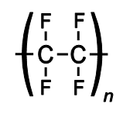Teflon: Sticky When It Comes to Health
Lessons Learned: Looking Back to Go Forward
A series of articles exploring historical events that provide an important lesson for ensuring a more sustainable and healthy environment. Originally published as a bulletin feature for the newsletter of CHE-WA (Collaborative on Health and the Environment, Washington State chapter); produced by Steven G. Gilbert.
 Teflon (polytetrafluoroethylene or PTFE) was accidentally discovered by Roy J. Plunkett (June 26, 1910 - May 12, 1994), a PhD research chemist employed by E.I. du Pont de Nemours and Company at their Jackson Laboratory in Deepwater, New Jersey. On April 6, 1938 he checked a cooled container of tetrafluoroethylene and found it had polymerized into polytetrafluoroethylene, which was trademarked as Teflon in 1945.
Teflon (polytetrafluoroethylene or PTFE) was accidentally discovered by Roy J. Plunkett (June 26, 1910 - May 12, 1994), a PhD research chemist employed by E.I. du Pont de Nemours and Company at their Jackson Laboratory in Deepwater, New Jersey. On April 6, 1938 he checked a cooled container of tetrafluoroethylene and found it had polymerized into polytetrafluoroethylene, which was trademarked as Teflon in 1945.
Teflon is a waxy solid with amazing properties such as resistance to corrosion, low surface friction, and high heat resistance. It became ubiquitous in household products such as electrical cable insulation, soil and stain repellent for fabrics, and coatings for non-stick cookware. Interestingly, it was first used by the military in artillery shell fuses and in the production of nuclear material for the Manhattan Project.
 Perfluorooctanoic acid (PFOA or C8), which has been industrially produced since the 1940s, is used as a surfactant in the emulsion polymerization of PTFE and has been detected in some PTFE. PFOA is a recognized toxicant that has been found to cause cancer in animal studies and is highly persistent in the environment. It is detected in the blood of general populations in the low parts per billion range, and some studies have associated it with infertility, higher cholesterol, and thyroid disease. PFOA has been detected in industrial waste, stain-resistant carpets, carpet-cleaning liquids, house dust, microwave popcorn bags, water, food, and PTFE. It was added to Annex B of the Stockholm Convention on Persistent Organic Pollutants in May 2009. These chemicals, as a whole, are called PFAS (per- and polyfluorinated alkyl substances); previously they have been called PFCs (perfluorinated compounds).
Perfluorooctanoic acid (PFOA or C8), which has been industrially produced since the 1940s, is used as a surfactant in the emulsion polymerization of PTFE and has been detected in some PTFE. PFOA is a recognized toxicant that has been found to cause cancer in animal studies and is highly persistent in the environment. It is detected in the blood of general populations in the low parts per billion range, and some studies have associated it with infertility, higher cholesterol, and thyroid disease. PFOA has been detected in industrial waste, stain-resistant carpets, carpet-cleaning liquids, house dust, microwave popcorn bags, water, food, and PTFE. It was added to Annex B of the Stockholm Convention on Persistent Organic Pollutants in May 2009. These chemicals, as a whole, are called PFAS (per- and polyfluorinated alkyl substances); previously they have been called PFCs (perfluorinated compounds).
This is another chemical with interesting and useful properties that we did not sufficiently investigate for potential hazards before bringing into our homes and releasing into our environment.


